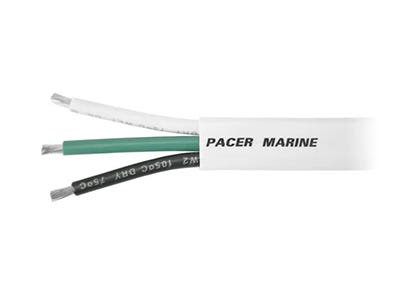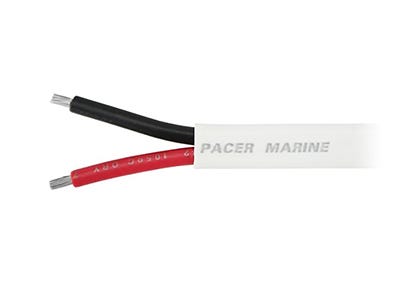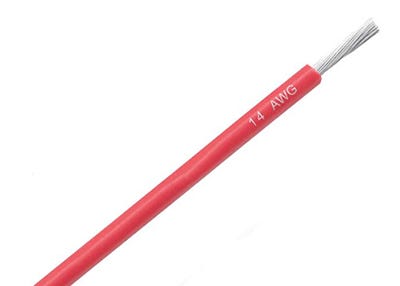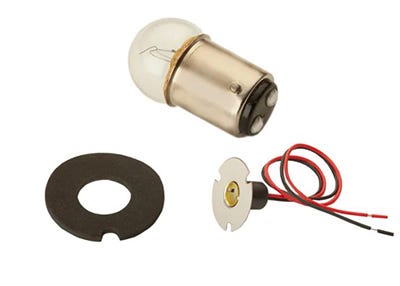

Sorting out wire gauge, fuse/circuit breaker rating, and switch function for marine electrical accessories can be downright daunting, often involving more math than you’ve done since high school. Of course, there’s plenty of motivation for getting the numbers right: screw them up and you risk your boat catching on fire.
That being said, the fact is that you don’t have to work out all the specifics for every single installation; for most new lights, pumps, and other machinery installed on boats under 40 feet or so, you only need to know a few fairly simple guidelines and always err on the side of caution. Understand that these recommendations are only a starting point. Always check the manufacturer’s amperage specifications for new electrical accessories.
Contents
- 1. A Few Things to Keep In Mind
- 1.1 Minimum Wire Size = 16 AWG
- 1.2 Breakers and Fuses Protect Wire
- 1.3 Switches Are Either 15A or 20A
- 1.4 No Need for Oversized Wire
- 2. Bilge and Livewell Pumps
- 3. Washdown Pumps
- 4. Macerator Pumps
- 5. Navigation and Courtesy Lights
- 6. Spreader Lights, Spotlights and Light Bars
- 7. Jackplates
- 8. Anchor Windlasses
A Few Things to Keep In Mind
Navigating the intricate world of boat wiring and circuit protection is a crucial aspect of ensuring a safe and reliable electrical system on board. Circuit protection devices, such as fuses and breakers, play a crucial role in safeguarding wiring from excessive current, emphasizing the need for proper sizing and placement.
This guide explores these key considerations to ensure a reliable and safe electrical system on your boat.
Minimum Wire Size = 16 AWG
The American Boat and Yacht Council (ABYC) and common sense say that the minimum wire size on a boat should be 16 AWG unless the wire is bundled with others that can support it.
That’s good advice. There’s just no good reason to use the smaller and more delicate 18 AWG. Cost savings are minimal and chances of failure are significantly higher.
Breakers and Fuses Protect Wire
Circuit protection devices (fuses and circuit breakers) are meant primarily to protect the circuit’s wiring, not the device the circuit powers. Too much current (amps) can melt wiring insulation and start fires. Fuses and breakers keep that from happening.
That being said, if your device manufacturer specifies a 5A fuse and the wire on your circuit can handle 20A, you should still use a 5A fuse. Note too that in order to protect the circuit itself, circuit protection devices need to be as close as possible to the battery or distribution panel. Locating a fuse at the end of a wire run, rather than the beginning, does little to protect the wire.
Locating a fuse at the end of a wire run, rather than the beginning, does little to protect the wire.
Switches Are Either 15A or 20A
Ratings for marine rocker switches and push-button switches aren’t nearly as specific as those for breakers and fuses. The vast majority of switches are rated for either 15A or 20A.
For low-draw items like nav lights and smaller bilge pumps, 15A is plenty. Otherwise, there’s no downside to 20A switches.
No Need for Oversized Wire
There’s no advantage to oversized wire. As long as a circuit is capable of carrying the required amperage without too much voltage drop (3% for critical devices or 10% for non-critical), stepping up the wire gauge will make no difference in performance. Yes, always err on the larger side, but don’t waste money on 10 gauge wire when 14 is all that’s needed.
Bilge and Livewell Pumps
Bilge and livewell pumps are essentially the same animal — 12VDC or 24VDC centrifugal pumps rated for 360 to around 4,000 gallons per hour.
Looking at 12V models — by far the most common — the smallest draw around 2.5 amps and the largest around 12 amps.
Typically, bilge pumps are wired with an ON-OFF-ON switch, with one ON position for automatic operation and the other for manual operation.
- Wire gauge: 16 AWG, except 14 for large pumps with round-trip wire runs over 20’.
- Switch: ON-OFF-ON 15A
- Fuse/breaker: See manufacturer specs. Typically 3A - 25A.
Washdown Pumps
Washdown pumps are typically diaphragm pumps that produce higher pressure at lower volumes that bilge and livewell pumps. They also draw significantly more current, from 7A or 8A up to 25A or so for the biggest pumps.
-
Wire gauge: 14 AWG minimum for smaller pumps and shorter runs. Otherwise 12 AWG.
-
Switch: ON-OFF 20A
-
Fuse/breaker: See manufacturer specs. Typically 10A to 25A
Macerator Pumps
Macerator pumps don’t just move water; they also grind up and pump solids, either wastewater or fishbox debris. That of course requires more power, and a typical marine macerator pump pulls 10A to 20A.
-
Wire gauge: 14 AWG or 12 AWG for most applications
- Switch: ON-OFF 20A
- Fuse/breaker: See manufacturer specs. Typically 20A or 25A
Navigation and Courtesy Lights
Even incandescent navigation lights don’t consume much amperage — 3 or 4 amps for your red and green bow lights and white all-around light combined. LED nav lights and courtesy lights pull only a fraction of that. The bottom line is that for virtually any run length, you need only the ABYC minimum 16 AWG wire.
Nav lights are typically wired with an ON-OFF-ON switch, with one ON position for all lights and the other for the white all-around light only.
-
Wire gauge: 16 AWG
-
Switch: ON-OFF-ON 15A
-
Fuse/breaker: See manufacturer specs. Typically 3A.
Spreader Lights, Spotlights and Light Bars
Lights designed to illuminate your decks or surroundings are much brighter and draw much more current than navigation and courtesy lights. They also vary widely in amperage. The biggest LED light bars can draw upwards of 20A.
-
Wire gauge: See manufacturer specs. Typically 16 AWG or 14 AWG.
-
Switch: ON-OFF 20A
-
Fuse/breaker: See manufacturer specs. Typically 5A to 25A
Jackplates
Hydraulic jackplates are powered by electric motors that use lots of amps to lift outboard motors weighing many hundreds of pounds.
-
Wire gauge: Most manufacturers recommend 10 AWG from the battery or distribution panel to the relay. Longer runs may require 8 AWG. Don’t skimp.
-
Switch: MOMENTARY ON - OFF - MOMENTARY ON 20A
-
Fuse/breaker: See manufacturer specs. Typically 40A or 50A resettable.
Anchor Windlasses
Anchor windlasses require lots of power, up to 200A, and are typically located far from the battery or distribution panel. For many applications, a separate battery bank close to the bow powers the windlass. Always consult manufacturer documentation when installing a windlass.
-
Wire gauge: See manufacturer specs. At least 8 AWG
-
Switch: MOMENTARY ON - OFF - MOMENTARY ON at least 20A
-
Fuse/breaker: See manufacturer specs.




